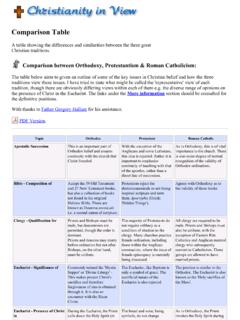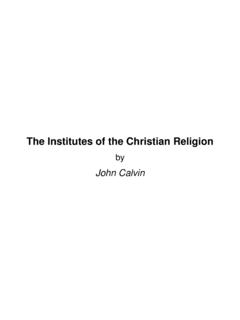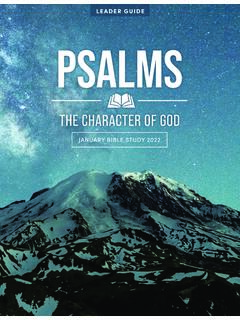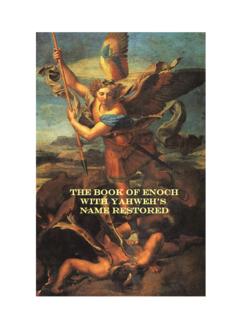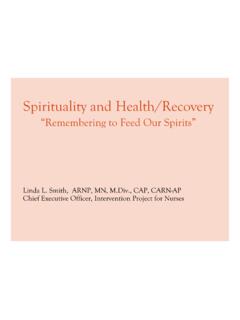Transcription of Sacraments – An Essay - Christianity in View
1 Sacraments An EssayBy: Iain A. EmbersonDate: 20 October 20091 Outline1. Introduction2. Sacraments - Definitions and History3. Sacraments - Efficacy and Mode of Operation4. Sacraments in Action I - Baptism5. Sacraments in Action II - Holy Communion6. Conclusion7. Bibliography2 Sacraments are amongst the most visible forms of outward expression in Christianity , coming as they do with significant variations, both in number and in practice. This Essay will examine their theological and historical background, and their significance in the ongoing life of the church. We also focus on the two main Sacraments as practised in Protestant Christianity , viz. Baptism and Holy - Definitions and HistoryThe early church recognised a number of rites or practices which in some way expressed the 'mystery' (Greek: mysterion) of the Christian faith. McGrath points out that from an early stage, a connection was made between the Sacraments of Baptism and Holy Communion and the mystery of God's saving work in Christ.
2 1 Tertullian (c. 160-220) translated the Greek term into Latin, by using sacramentum, a word which in a secular sense meant an oath of allegiance, for example the sort that a soldier might make to his commanding 4th century theologian Augustine of Hippo defined a sacrament as an outward and visible sign of an inward and invisible grace . Despite this definition, there was no widespread agreement as to the number of rites that could properly be called Sacraments . It was not until the 12th century, with the work of Peter Lombard (1100-1160), that the Sacraments were systemised and their total number listed as seven. These were Baptism, Confirmation, Holy Communion, Marriage, Holy Orders, Penance and Unction. All of these, it was argued were instituted by Christ 2 and remain (with differences in terminology for some of them), the Sacraments of the Roman Catholic and Orthodox Churches (both Eastern and Oriental), though in Orthodoxy the list is not fixed at McGrath, Christian theology : An Introduction, stated and confirmed by, for example, The Council of Trent (1545-1563).
3 3 The Protestant Reformation resulted in these seven being reduced to just two (with a few exceptions) These were Baptism and Holy Communion, with both having the explicit command of Christ in scripture (Matthew 28:19-20 for Baptism and Luke 22:19-20 for Holy Communion). Some Protestant groups preferentially use the term ordinance to refer to the Sacraments , in the sense that they were ordained or commanded by Christ see this transition from seven to two in the works of Martin Luther (1483-1546). His emphasis on a visible physical sign of God's promises formed the backdrop to his rationale for only permitting two Sacraments ; having originally allowed penance as a sacrament, but later rejecting it. Luther's argument was that ..only in these two [Baptism and the Bread] do we find the divinely instituted sign and the promise of the forgiveness of sins. 4 John Calvin (1509-1564) offered his own definition of the Sacraments in the Institutes, arguing that the Sacraments are visible signs affirming the promises of God:We have determined, therefore, that Sacraments are truly named the testimonies of God's grace and seals of the good will that he feels toward us, which by attesting that good will to us, sustain, nourish, confirm and increase our faith.
4 - Efficacy and Mode of OperationAugustine pointed out the connection between sacramental signs and grace. However, several different perspectives on this relationship arose out of the Reformation. To begin with, the classic position as held by the Roman Catholic Church states that the Sacraments give grace directly, of their own power. They are thus channels of grace and effectively communicate the grace that they Protestants, the Salvation Army and the Quakers are , Babylonian Captivity of the , Institutes of the Christian Religion, Book 4, chapter The Sacraments are efficacious signs of grace, instituted by Christ and entrusted to the Church, by which divine life is dispensed to us. The visible rites by which the Sacraments are celebrated signify and make present the graces proper to each sacrament. 6An essential principle is that grace is received ex opere operato (Latin: 'from the work done') , that is, irrespective of the virtue or those who administer or receive the Sacraments .
5 However, for this grace to be received freely, recipients should receive the Sacraments with proper disposition .During the Reformation period, this Catholic view came to be challenged by Luther amongst others, who increasingly began to talk of faith as being an essential requirement to receiving grace. Some other Protestants preferred to talk of the Sacraments as being symbols rather than the means of grace. Grudem discusses a Protestant/Catholic difference on the means of grace:[ Sacraments are viewed] as means of salvation that make people more fit to receive justification from God. But on a Protestant view, the means of grace are simply an additional blessing within the Christian in Action I BaptismThe rite of Baptism (from the Greek baptizo: 'immerse' or 'cleanse') is practised by the majority of Christian denominations, having its origins in the Great Commission of Matthew 28:19 and application in, for example Acts 2:38 where it is mentioned alongside repentance.
6 Christians are however divided on the purpose and also the practice of of the Catholic Church, , systematic theology , The Roman Catholic view is that Baptism effects saving ('sanctifying') grace to the recipient, and the remission of ..all punishments of sins, both eternal and temporal. 8 Baptism brings about spiritual birth or 'regeneration' directly and also joins one to the body of Christ, the church. It is also essential for salvation. In Orthodoxy, Baptism is ..the beginning of Christian life, the entrance into the wholeness of the Church. 9 The Lutheran view is broadly similar to the Roman Catholic, but faith is an essential prerequisite. Indeed Baptism works by strengthening faith and is a means of grace. Luther summarised it as follows: In Baptism God forgives sin, delivers from death and the devil, and gives everlasting salvation to all who believe what he has promised.
7 10 The Reformed and Presbyterian view is that Baptism as a sign and seal of the covenant . 11 John Calvin argued that the theme of baptism is incorporation into the faith and discipline of the of the groups mentioned thus far, practice Baptism of infants (paedobaptism). For example those who stress Baptism as initiation into the covenant argue that it is inclusive. Luther justified the practice by arguing that it was pleasing to that God sanctifies many of them who have been thus baptised, and has given them the Holy Ghost. 12 The practice of paedobaptism was challenged by the Anabaptists and those on the radical wing of the Reformation, who argued that the rite was only applicable to those who were able to make a conscious profession of faith and repentance. Baptism is thus a witness or testimony to an individual's experience of faith and has no objective effect on the person , Fundamentals of Catholic Dogma, , Eastern Orthodoxy Through Western Eyes, , Small Catechism, IV, Larger Catechism, 176-7.
8 12 Luther, Large Catechism, XIII, Infant 5. Sacraments in Action II - Holy CommunionThe sacrament of Holy Communion is also known by several different names such as Eucharist, Lord's Supper, Divine Liturgy and the Mass. The New Testament gives varying details of the institution of Holy Communion by Christ himself (Matthew 26:26-28, Mark 14:22-24, Luke 22: 19-20 and 1 Corinthians 11:23-25). In contrast to Baptism, which as a sacrament is normally non-repeatable, there are varying degrees of repetition of Holy Communion, ranging from daily (as in the Catholic Church) to more infrequent celebrations (such as in some Reformed churches).As with Baptism, there is widespread diversity in both the practice and significance of the sacrament and the divergent understandings have proved an obstacle in some cases to a common celebration between churches. Yet most parties would probably agree that the rite confers some kind of spiritual benefit to those who receive the Catholic Church, the term 'Eucharist' (Greek: eucharist a, 'thanksgiving') or 'Holy Sacrifice of the Mass' or simply 'Mass' is generally used for the rite.
9 The full wording expresses the Catholic view that the sacrament 're-presents' or makes present the sacrifice of Christ on the Cross. This sacrifice is the same is that on Calvary, albeit in a unbloody 13 The Mass is also in a sense a renewal of the new covenant between God and Man. 14 Roman Catholic belief emphasises the true and literal presence of Christ in the communion elements (bread and wine). Upon consecration by the priest, the elements change completely into the actual body and blood of Christ, a view known as the Real Presence of Christ in the Eucharist and a process known as may summarise the Catholic view of the Eucharist as spiritual food for the soul; it strengthens [the] participant and frees from venial sins. of the Catholic Church, II, Constitution On the Sacred Liturgy, House, Charts of Christian theology and Doctrine In Orthodoxy, the rite is generally known as the 'Divine Liturgy'.
10 Like Roman Catholicism, Orthodoxy affirms the real presence of Christ, without any explicit attempt to explain it, thus consistent with the Orthodox view of the Sacraments as 'Mysteries'.A number of differing views regarding the purpose of the sacrament came to be formulated as a result of the Reformation. To begin with, Luther put forward an alternative view, popularly known as consubstantiation, which indicates that on consecration, the elements do not change completely into the body and blood of Christ, rather he is present 'in, with and under' them. Lutheran theology often refers to this as a sacramental union and in keeping with Luther's view, regards faith as essential for those who receive the Swiss Reformer Ulrich (or Huldrych) Zwingli (1484-1531) interpreted Christ's words in Matthew 26:26 ('This is my body') in a non literal manner. Zwingli argued that the word 'is' should actually be interpreted to mean 'signifies', a view known as memorialism.

